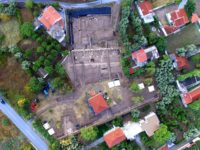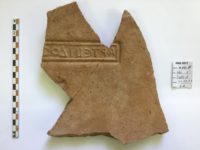 An international team of archaeologists led by the Swiss School of Archaeology in Greece (ESAG) in collaboration with the regional archaeological service have discovered the remains of the long-lost temple of Artemis near the village of Amarynthos on the island of Euboea in Greece.
An international team of archaeologists led by the Swiss School of Archaeology in Greece (ESAG) in collaboration with the regional archaeological service have discovered the remains of the long-lost temple of Artemis near the village of Amarynthos on the island of Euboea in Greece.
Under the current director the excavations, University of Lausanne Professor Karl Reber, the team has been searching for the sanctuary since 2007, but they’re the new kids on the block, comparatively speaking. Researchers have been looking in vain for more than a century. The first Swiss archaeologists were invited to explore the ancient city of Eretria for the temple in 1964. Eleven years later, that initial foray cemented itself into a permanent institution when the mission was recognized by the Greek national government as the Swiss School of Archaeology in Athens. The dig has been so successful it has continued for more than 50 years. In 2014, 50 years after the first Swiss excavation broke ground in Eretria, the ESAG team could claim to have cleared the temple of Apollo, a shrine to Athena, the fortifications of the city’s western gate, a theater, luxury villas with elaborate mosaics, Roman-era public baths and a large gymnasium.
The sanctuary of Artemis Amarynthia, however, remained elusive. If it had ever been in Eretria, the Swiss team could find no trace of it. Starting in 2007, they moved further afield to study the environs of the city, territories under its control but not part of the actual city itself. At the foot of the Paleoekklisies hill just over five miles east of Eretria, ESAG archaeologists found a monumental portico dating to the 4th century B.C. that ran along the east and north boundary of an open-air structure.
This summer, the team dug survey trenches inside the portico perimeter in the hope of finding evidence from the most central location that this was indeed the much sought-after sanctuary. They were successful beyond their wildest dreams. They found the remains of a number of structures constructed between the 6th-2nd century B.C. (the period when the temple was at its most active) and an underground fountain made of architectural blocks and the recycled bases of monumental statues. Those statue bases proved to be the smoking gun that identified the temple. They were inscribed with dedicated to Artemis, her twin brother Apollo and their mother Leto.
 The inscriptions and the architectural significance of the materials strongly indicate that this was the Artemis sanctuary. That was confirmed by another discovery, not as glamorous as the statue bases, more on the utilitarian side, but just as meaningful to archaeologists: multiple tiles stamped with the name “Artemidos” (meaning “of the Artemis”) inside a rectangular cartouche.
The inscriptions and the architectural significance of the materials strongly indicate that this was the Artemis sanctuary. That was confirmed by another discovery, not as glamorous as the statue bases, more on the utilitarian side, but just as meaningful to archaeologists: multiple tiles stamped with the name “Artemidos” (meaning “of the Artemis”) inside a rectangular cartouche.
Now, after also finding artefacts with inscriptions, they are sure that they have located the site of the Artemis Amarynthia, which was the end point of the annual procession of people from the once prosperous trading city of Eretrea, 10km away. They held a festival in honour of Artemis, the untameable goddess of hunting in Greek mythology. She was worshipped as the patron goddess of Amarynthos, which takes its name from an Eretrean man who was besotted by Artemis.
Yes, a house built on an ancient temple, so what goes on in its basement, I wonder, and that shed off to the left in those trees on the aerial photo, that looks suspicious, there is bound to be something nasty in the woodshed!